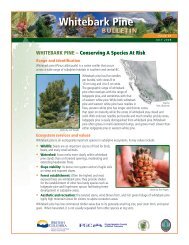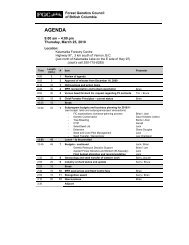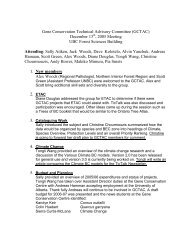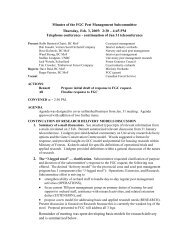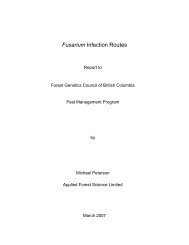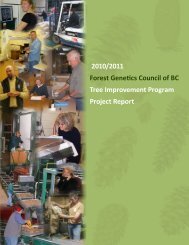Tree Improvement Program Project Report 2006 / 2007
Tree Improvement Program Project Report 2006 / 2007
Tree Improvement Program Project Report 2006 / 2007
You also want an ePaper? Increase the reach of your titles
YUMPU automatically turns print PDFs into web optimized ePapers that Google loves.
.2.6 Enhanc ng Seed Product on n<br />
North Okanagan Lodgepole<br />
P ne Seed Orchards<br />
(SPU 0719)<br />
Chr s Walsh and Joe Webber<br />
The OTIP SPU 0719 final report for 2005 provided a<br />
complete summary of the lodgepole pine seed set study for<br />
the period of 2000 to 2005. Over that period, the improved<br />
irrigation system did not result in substantial increases<br />
in seed yields, although cone mass and seed weights have<br />
improved. Temperature and drought conditions during<br />
the pre-pollination, pollination, fertilization, and embryo<br />
development periods have not been severe, and soil<br />
moisture content has been adequate. Crown misting has<br />
also not been necessary. Again weather conditions during<br />
the sensitive periods of reproductive development have not<br />
limited either pollen uptake or fertilization and embryo<br />
development.<br />
There is growing concern that both seed yields and<br />
cone numbers are declining over the last three years. This<br />
downward trend is observed across the orchard in general<br />
and is not associated with culture (over-watering) although<br />
over-watering may exaggerate this trend. Lower cone<br />
numbers may be the result of decreasing tree vigour caused<br />
by crown shading that comes from increased tree size. Also,<br />
cone numbers may be dropping because the sampling<br />
points have become increasingly lower in the crown.<br />
Although sampling now considers crown position (high and<br />
low), cone numbers are still declining.<br />
We have no reason to suspect pollen supply (uptake)<br />
as the cause of the decline, especially in the upper crown<br />
seed cones, although pollen supply in the lower crown (in<br />
large trees) may be limiting. Since this orchard is nearing<br />
20 years old, we must suspect the vigour of the trees as a<br />
cause of lower cone and seed production. We also need to<br />
consider whether insect damage to first-year cones after<br />
harvesting can adversely affect yields the following year.<br />
Because the pre- and post-pollination season was not<br />
hot and dry, we abandoned monitoring cultural effects on<br />
seed set. However, we monitored insect damage, pollen<br />
supply to lower crown cones, and weather. Increasing lower<br />
crown pollen supply (control crosses and SMP) did not<br />
improve seed set, and insect losses were in the range of 10<br />
filled seed per cone in upper crown cones. We have noted<br />
that insect seed losses increase with heat. The year <strong>2006</strong> was<br />
2<br />
T R E E I M P R O V E M E N T P R O G R A M<br />
P R O J E C T R E P O R T 2 0 0 6 / 2 0 0 7<br />
relatively cool during the pre- and post-pollination period<br />
but was unusually hot and dry during June and September.<br />
RESULTS<br />
Lower crown pollen supply<br />
We used both control cross pollination and SMP to<br />
determine if pollen supply to lower crown cones was<br />
limiting seed yields. We treated lower crown cones with<br />
SMP in 2005 and then compared them with openpollinated<br />
cones in upper crowns, both with and without<br />
insect protection (bagging). We compared cones treated<br />
with control crossing in the lower crown with OP cones in<br />
both the lower and upper crowns.<br />
Figures 33 and 34 show the effect of SMP on lower<br />
crown cones for both total seed per cone (TSPC) and filled<br />
seed per cone (FSPC). Figures 33 and 34 also show the<br />
effect of insect protection on lower (SMP) and upper crown<br />
cones (OP only). Increasing pollen supply (SMP) to lower<br />
crown cones did not improve either TSPC or FSPC, but<br />
the effect of insect protection is apparent. About 10 FSPC<br />
were lost in the upper crown from insect predation, but the<br />
loss was less than two for lower crown cones.<br />
Figures 35 and 36 show the effect of control cross<br />
pollination on lower crown cones compared to OP<br />
cones in both the upper and lower crowns. There was a<br />
slight decrease in FSPC (about four) from OP cones in<br />
lower compared to upper crown cones, and control cross<br />
pollination did not improve the number of FSPC in the<br />
lower crown.<br />
Meteorolog cal data<br />
Temperature (Tsum) and vapour pressure deficit (VPDsum)<br />
sums are shown for the irrigation block only. Tables 13 to<br />
16 show the meteorological data for four important periods<br />
of reproductive development in lodgepole pine. April to<br />
mid-May represents the period of rapid second-year cone<br />
development and pre-pollination development of the firstyear<br />
cones. The last two weeks of May represent the period<br />
of flowering, pollination, pollen uptake, and early pollen<br />
development (penetration of the nucellus). June represents<br />
the period of fertilization and early embryo development<br />
of the second-year cones, and September is the period of<br />
differentiation of first-year cones (although recent data on<br />
describing the period of seed cone differentiation suggest<br />
that it occurs much earlier).<br />
Heat sums, vapour pressure deficits, and precipitation<br />
vary by year and period of reproductive development.<br />
During pre-pollination, <strong>2006</strong> was an average year with



